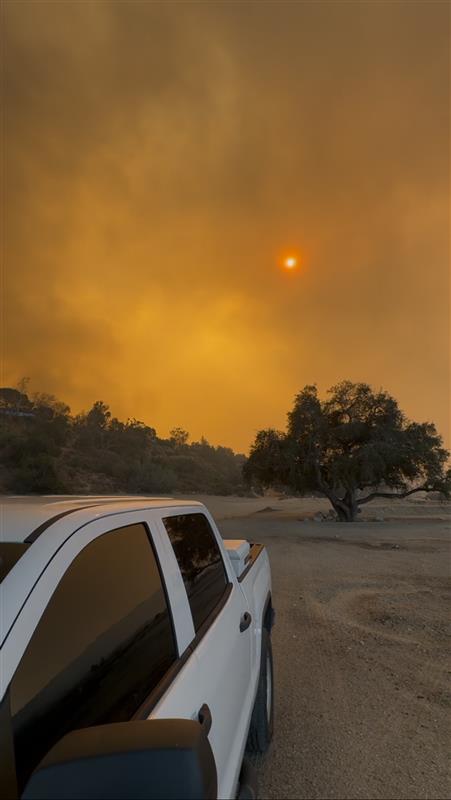Planning, communication key to California wildfire response
April 15, 2025


AWWA Articles
Planning, communication key to California wildfire response
When a destructive wildfire raged through Eaton Canyon in the San Gabriel Mountains of Los Angeles County in January, it was all hands on deck for Pasadena Water and Power (PWP).
On Jan. 7, staff at the community-owned utility were on high alert for a weather system bringing powerful, dry Santa Ana winds to the drought-plagued region. In response to the National Weather Service’s red flag warnings, emergency protocols were being followed, including having extra crews on duty and on call and pre-filling water reservoirs.
Jennifer Guess Mayo, PWP’s assistant general manager of external affairs, recalls being at home that evening when she heard news about a local fire. “It was very scary to have it that close,” she said. “The sky turned orange, and it was raining ash. We were checking on staff, family members and friends. Though my family’s home wasn’t threatened, we ended up hosting friends in the middle of the night.”
During the quickly evolving catastrophe, residents endured several days of zero containment of the dangerous Eaton wildfire. The city opened an emergency operations center with “all the key players in the room,” including the Pasadena Fire Department, Public Works Department, representatives from PWP water, and electric teams who tracked the emergency on SCADA (supervisory control and data acquisition) maps.
“There was a tremendously heartfelt outpouring of support for our colleagues who lost their homes but continued to do their jobs,” she said. “Calls were made to check on all PWP employees, and people were working very long shifts around the clock. The dedication was really palpable.”

Fortunately, PWP did not receive reports of loss of water pressure or dry hydrants, although statewide firefighting resources were strained due to the Palisades Fire being fought concurrently in the Santa Monica Mountains.
“Pasadena suffered devastating loss, with hundreds of structures destroyed,” Guess Mayo said. “We feel the pain and heartbreak that comes with such destruction. Our neighboring City of Altadena endured even greater tragedy, losing thousands of structures. Our hearts go out to everyone affected as we stand in solidarity with each other.”
Because the Eaton Fire impacted several city water infrastructure facilities, including reservoirs/tanks, the utility issued a “do not drink” notice for a week and half.
“With the fire still going, our infrastructure and facilities in the burned zones needed to be assessed for their integrity, so we made the call out of an abundance of caution,” Guess Mayo said.
The PWP team, including operations and construction crews, engineers, and water quality experts, worked around the clock and systematically assessed all potentially Eaton Fire-impacted water facilities.
“Kudos go to the amazing work of our water teams that worked with the Water Resources Control Board to make sure we could confirm safe drinking water quality and gradually lift the ‘do not drink’ notice,” Guess Mayo said.
Frequent communications key strategy
Keeping PWP’s 67,000 customers informed was key to managing the disaster, especially since neighboring water agencies were responding to different conditions. The utility issued frequent press releases, social media updates, mass email notifications (in English and Spanish), and website posts using an interactive GIS (geographic information system) map of its water service area. This enabled PWP water customers to see which neighborhoods were no longer under the “do-not-drink” notice.
“The GIS map was a useful tool,” Guess Mayo said. “It made everything much easier to communicate and enabled people to see visually that things were getting better each day. It was good to have something like that at the ready.”
PWP also posted Frequently Asked Questions providing information about how residents could safely use water for showering and washing dishes and clothes.
“It was important to alleviate our customers’ anxiety both immediately and during the span of the ‘do not drink’ notice,” Guess Mayo said. “We also provided information about what to do when they returned to their homes, like flushing their water lines.”

PWP opened a bottled water distribution center in partnership with Los Angeles County Public Works, where employee volunteers gave away more than 500,000 bottles in several days. The utility also provided updates through a booth that PWP volunteers staffed for nearly two weeks at the local FEMA disaster center.
The Eaton Fire was fully contained on Jan. 31 after burning for 24 days, and PWP is in recovery mode, still focused on the health and safety of its customers and staff.
“Our biggest priority is getting customers back into homes and easing that process as much as we can,” Guess Mayo said. That includes expediting new service connections, prioritizing getting water and energy services turned back on and alleviating some of the cost through temporarily expanding an existing water leak assistance program. “Some residents who were evacuated left the hose running to cool their roof, and that left the water meter running.” PWP also expanded the leak assistance program to help cover fire damage related leaks.
“Our call center has received some emotional calls and provided support and comfort in unprecedented times,” she added. “We heard from customers who needed to turn off their water service because their home was destroyed.”
Recovery from a windstorm and wildfire is a complex process that requires time, effort and collaboration. As communities are rebuilt, local utilities remain a key partner, working to restore infrastructure and strengthen preparedness through coordinated efforts, improved systems and a shared commitment to resilience.
